As the calendar flips to winter, Delhi, the capital of India, faces a recurring environmental nightmare: stubble burning. The air turns hazy, the sky loses its azure hue, and the city’s residents don masks to protect themselves from the suffocating air. Stubble burning, the practice of setting fire to crop residue after the harvest season, is a grave issue that poses a severe threat to the environment and public health. Annually, there are about 54,000 deaths due to air pollution in Delhi-NCR alone.
In a day, on average, 38% of the particulate matter pollution comes from stubble burning in the winter months from the neighbouring state of Punjab. The severity of this problem calls for urgent policy action. In this article, we will delve into the causes and consequences of stubble burning in Delhi-NCR and explore potential solutions to combat this looming crisis.
The Issue
The northern states of India, specifically Punjab and Haryana, are often referred to as the nation’s agricultural heartland. Following the harvest of rice and wheat, farmers are confronted with substantial amounts of crop residue, commonly known as stubble. The narrow time gap between harvest and the subsequent planting season compels many farmers to opt for the quickest and most cost-effective disposal method, which involves setting the stubble ablaze. While this may offer a rapid solution to farmers, it gives rise to extensive repercussions.
Environmental Challenges
Stubble burning results in a range of environmental challenges, with the most immediate being the degradation of air quality. During the burning season, air quality indices in areas affected often deteriorate to ‘hazardous’ levels, with PM2.5 and PM10 levels far exceeding safe limits. The smoke and particulate matter released during this period, contain hazardous pollutants and toxins that contribute to air pollution in the region, further exacerbating the existing air quality crisis in Delhi. These cause a myriad of health complications, including respiratory diseases and premature mortality. Further, the smoke generated from stubble burning can carry fine particulate matter over considerable distances, affecting not only the states where stubble is burnt, but also, compromising air quality in other neighbouring, transcending state borders and impacting a multitude of people.
Impact on Agriculture
The adverse consequences extend to agriculture as well. While stubble burning provides a quick fix for farmers, it has a detrimental long-term impact on soil quality, depleting its fertility and fostering dependence on chemical fertilizers. This nutrient loss in the soil hinders future agricultural productivity, thereby initiating a self-perpetuating cycle that ultimately undermines the livelihoods of farmers. Furthermore, stubble burning also imposes economic burdens, necessitating increased government expenditure on air quality monitoring, healthcare services for those affected, and compensation for crop losses, making it a pressing issue in need of comprehensive solutions.
A Comprehensive Strategy
Addressing the intricate issue of stubble burning requires a comprehensive strategy, which comprises several elements. Providing subsidies and financial incentives to farmers for the adoption of modern agriculture machinery like Happy Seeders and Mulching Machines can significantly reduce their dependency on stubble burning. Alongside this, public awareness campaigns that inform farmers about the environmental and health consequences of this practice while simultaneously training them on alternative residue disposal methods and their long-term benefits in sustainable agriculture, is also beneficial. None of these solutions are possible without the pivotal role of the government which encompasses financial incentives, technical assistance, and infrastructure development for proper crop residue management, directly supported by policies promoting sustainable farming practices. Further, collaborative efforts between state and central governments are also essential, given the cross-state nature of the stubble burning issue. Finally, stimulating innovation and research in agriculture to identify novel uses for crop residue, such as bioenergy production and eco-friendly product development, can provide farmers with economic incentives, ultimately discouraging the detrimental practice of stubble burning.
Conclusion
Stubble burning is a persistent problem in Delhi and the northern states of India that poses a grave threat to the environment, public health, and agriculture. While there are no easy solutions, a combination of government support, financial incentives, public awareness campaigns, and innovative agricultural practices can help mitigate this crisis. As the nation prepares for the winter months and the harsh consequences of stubble burning, addressing this issue must be a top priority to ensure a healthier, more sustainable future for all.


